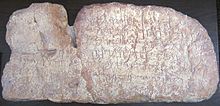| Siloam inscription | |
|---|---|
 | |
| Material | Stone |
| Writing | Paleo-Hebrew |
| Created | c. 700 BC |
| Discovered | 1880 |
| Present location | Istanbul Archaeology Museums |
| Identification | 2195 T |
The Siloam inscription, Silwan inscription or Shiloah inscription (Hebrew: כתובת השילוח), known as KAI 189, is a Hebrew inscription found in the Siloam tunnel which brings water from the Gihon Spring to the Pool of Siloam, located in the City of David in East Jerusalem neighborhood of Silwan ("Siloam" in the Bible). The inscription records the construction of the tunnel, which has been dated to the 8th century BC on the basis of the writing style.[1] It is the only known ancient inscription from ancient Israel and Judah which commemorates a public construction work, despite such inscriptions being commonplace in Egyptian and Mesopotamian archaeology.[1]
It is among the oldest extant records of its kind written in Hebrew using the Paleo-Hebrew alphabet,[2][3][4] a regional variant of the Phoenician alphabet. The inscription is part of the collections of the Istanbul Archaeology Museum.
- ^ a b Lemche 1998, p. 47; quote: "A good case can be made on the basis of the paleography to date the inscription in the Iron Age. The inscription itself, on the other hand, does not tell us this. It is only a secondary source, which in this case may be right but which can also be wrong, because nobody can really say on the basis of this anonymous inscription whether it was Hezekiah or some other Judean king from the eighth or seventh century who constructed the tunnel. As it stands, it is the only clear example of an inscription from either Israel or Judah commemorating a public construction work. As such it is a poor companion to similar inscriptions not least from Egypt and Mesopotamia."
- ^ "Siloam Inscription". Jewish Encyclopedia. 1906.
- ^ "THE ANCIENT HEBREW INSCRIPTION OF SILOAM". 1888.
- ^ Rendsburg, Gary; Schniedewind, William (2010). "The Siloam Tunnel Inscription: Historical and Linguistic Perspectives". Israel Exploration Journal. Retrieved 2015-05-02.